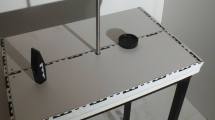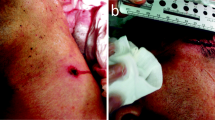Abstract
Backspatter is the ejection of biological material from a gunshot entrance wound against the line of fire. This phenomenon was investigated experimentally in transverse gunshots to the heads of calves (n = 9) using two types of 9 mm Parabellum ammunition from shooting distances of 0–10 cm. The resulting bloodstains were documented on white paper placed horizontally 60 cm below the impact site. In this report the analysis was restricted to stains with a diameter > 0.5 mm. Backspatter was documented after every gunshot. The number of stains varied from 31–324 per gunshot and appeared to be independent of the shooting distance. The maximum distance droplets travelled varied from 72–119 cm. The majority of droplets accumulated between 0 and 50 cm. The number of droplets and the distances travelled should be higher in man for anatomical reasons. The direction a single droplet can take comprises every possible angle between the most tangential ones to the skin surface. This resulted in a semi-circle of 180° covered with stains. Skin ruptures of the entrance wound were not observed. The succession of events was documented on high speed film and started with the recoil of the firearm, immediately followed by a blow-out effect of the skin. Large droplets exited approximately 0.7–4 ms after the bullet impacted the skin. The calculated minimum initial velocity of these droplets was 13–61 m/s. Backspatter from gunshots to the head likely is caused by the hot gases expanding subcutaneously and by cavitation-related intracranial overpressure and tail splashing. In three out of nine gunshots, secondary backspatter additionally occurred as a result of droplets produced by a stream of blood from the entrance wound impacting the paper surface.
Similar content being viewed by others
References
Amato JJ, Billy LJ, Lawson NS, Rich NM (1974) High velocity missile injury. An experimental study of the retentive forces of tissue. Am J Surg 127:454–458
Balthazard V, Piedelievre R, Desoille H, Derobert L (1939) Etude des gouttes de sang projete. Ann Med Leg Crim Pol Sci Med Soc Tox 19:265–323
Black AN, Burns BD, Zuckerman S (1941) An experimental study of the wounding mechanism of high-velocity missiles. BMJ 2:872–874
Brinkmann B, Madea B, Rand S (1985) Charakterisierung von Mikroblutspuren. Z Rechtsmed 94:237–244
Brinkmann B, Madea B, Rand S (1986) Zu den Einflußfaktoren auf die Morphologie der Blutspur. Beitr Gerichtl Med 44:67–73
Brüning A, Wiethold (1934) Die Untersuchung von Selbstmörder-schußwaffen. Dtsch Z Gerichtl Med 23:71–82
Burnett BR (1991) Detection of bone and bone-plus-bullet particles in backspatter from close-range shots to heads. J Forensic Sci 36:1745–1752
Callender GR, French RW (1935) Wound ballistics: studies in the mechanism of wound production by military rifle bullets. Milit Surg 77:177–201
DiMaio VJM (1985) Gunshot wounds. Elsevier, Amsterdam New York, p 301
Fraenckel P, Straßmann G (1924) Zur Entfernungsbestimmung bei Nahschüssen. Arch Kriminol 76:314–316
Gross H (1894) Handbuch für Untersuchungsrichter, Polizeibeamte, Gendarmen u.s.w. Leuschner und Lubensky, Graz
Harvey EN, Butler EG, McMillan JH, Puckett WO (1945) Mechanism of wounding. War Med 8:91–104
Herget CM (1953) Wound ballistics. In: Bowers WF (ed) Surgery of trauma. Lippincott, Philadelphia, pp 494–510
Hofmann v ER (1898) Lehrbuch der Gerichtlichen Medizin. Urban & Schwarzenberg, Wien Leipzig, 8 edn, p 389
Kirk PL (1967) Blood — a neglected criminalistics research area. Law Enforcement Science and technology, Vol 1. Academic Press, London, pp 267–272
Knight B (1977) Firearm injuries. In: Tedeschi CG, Eckert WG, Tedeschi LG (eds). Forensic Medicine. Saunders, Philadelphia, pp 510–526
Knudsen PIT, Svender J (1994) Doppler radar velocity measurements for wound ballistics experiments. Int J Legal Med 107:1–6
Lamprecht K (1959) Schuß durch Fensterglas. Arch Kriminol 123:128–132
Lochte T (1933) Über die Kronenbildung des auffallenden Bluttropfens und ihre Beziehungen zu sekundären Blutspritzern. Dtsch Z Gerichtl Med 22:387–396
Lorenz R (1948) Der Schußkanal im Röntgenbilde. Dtsch Z Gerichtl Med 39:435–448
MacDonell HL (1982) Bloodstain pattern interpretation. Laboratory of Forensic Science Publishers, New York, pp 16–21
Pex JO, Vaughan CH (1987) Observations of high velocity bloodspatter on adjacent objects. J Forensic Sci 32:1587–1594
Pizzola PA, Roth S, De Forest PR (1986a) Blood droplet dynamics-I. J Forensic Sci 31:36–49
Pizzola PA, Roth S, De Forest PR (1986b) Blood droplet dynamics-II. J Forensic Sci 31:50–64
Scott R (1983) Pathology of injuries caused by high-velocity missiles. Clin Lab Med 3:273–294
Sellier K (1969) Einschußstudien an der Haut. Beitr Gerichtl Med 25:265–270
Sellier K (1982) Schußwaffen und Schußwirkungen I. SchmidtRömhild, Lübeck, pp 207–214, 230, 331
Sellier KG, Kneubuehl BP (1994) Wound ballistics and the scientific background. Elsevier, Amsterdam New York, pp 179–180
Stephens BG, Allen TB (1983) Back spatter of blood from gunshot wounds — observations and experimental simulation. J Forensic Sci 28:437–439
Thornton JI (1974) Crime investigation. Wiley, New York, p 262
Wagner H-J (1963) Experimentelle Untersuchungen über Art und Ausmaß der Rückschleuderung von Blut und Gewebeteilen beim absoluten und relativen Nahschuß. Dtsch Z Gerichtl Med 54:258–266
Watkins FP, Pearce BP, Stainer MC (1988) Physical effects of the penetration of head simulants by steel spheres.J Trauma 28, No 1 [Suppl]:S40-S54
Weimann W (1931) Über das Verspritzen von Gewebeteilen aus Einschußöffnungen und seine kriminalistische Bedeutung. Dtsch Z Gerichtl Med 17:92–105
Werkgartner A (1924) Eigenartige Hautverletzungen durch Schüsse aus angesetzten Selbstladepistolen. Beitr Gerichtl Med 6:148–161
Ziemke E (1914) Die Untersuchung von Blutspuren. In: Lochte T (ed) Gerichtsärztliche und polizeiärztliche Technik. Bergmann, Wiesbaden
Zwingli M (1941) Über Spuren an der Schießhand nach Schuß mit Faustfeuerwaffen. Arch Kriminol 108:1–26
Author information
Authors and Affiliations
Rights and permissions
About this article
Cite this article
Karger, B., Nüsse, R., Brinkmann, B. et al. Backspatter from experimental close-range shots to the head. Int J Leg Med 109, 66–74 (1996). https://doi.org/10.1007/BF01355519
Received:
Revised:
Issue Date:
DOI: https://doi.org/10.1007/BF01355519




